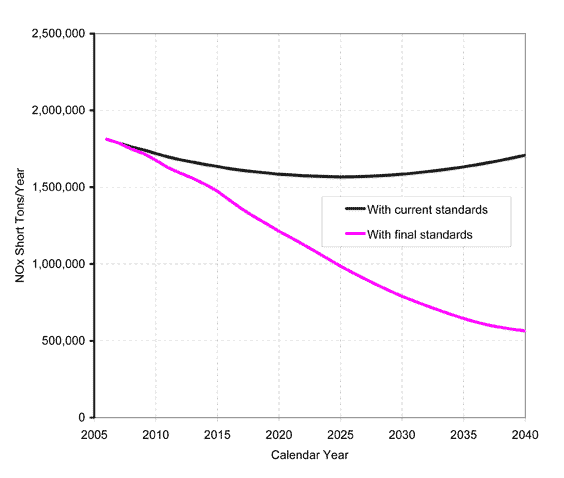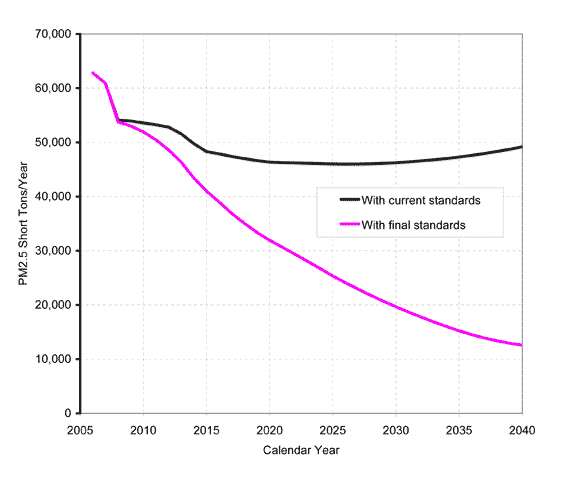REGULATORY ANNOUNCEMENT
EPA Finalizes More Stringent Emissions Standards for Locomotives and Marine Compression-Ignition Engines
EPA420-F-08-004, March 2008
Download PDF version formatted for print. (5 pp, 144K, About PDF Files)
The U.S. Environmental Protection Agency (EPA) is adopting standards that will dramatically reduce emissions of diesel particulate matter (PM) and nitrogen oxide (NOx) from locomotives and marine diesel engines. This three-part program aims to:
- tighten emissions standards for existing locomotives and large marine diesel engines when they are remanufactured;
- set near-term engine-out emissions standards, referred to as Tier 3 standards, for newly-built locomotives and marine diesel engines; and
- set longer-term standards, referred to as Tier 4 standards, for newly-built locomotives and marine diesel engines that reflect the application of high-efficiency aftertreatment technology.
EPA is also finalizing new idle reduction requirements for newly-built and remanufactured locomotives and adopting provisions to encourage a new generation of clean switch locomotives, based on clean nonroad diesel engine standards. This rule completes an important step in EPA's ongoing National Clean Diesel Campaign (NCDC).
EPA estimates 90 percent PM reductions and 80 percent NOx reductions from Tier 4 engines meeting these standards, compared to engines meeting the current Tier 2 standards. By 2030 this program will reduce annual emissions of NOx by about 800,000 tons and PM emissions by 27,000 tons and those emission reductions continue to grow beyond 2030 as fleet turnover is completed.
- Changes from Proposed Rule
- Background
- Need to Reduce Locomotive and Marine Diesel Emissions
- Description of Engines Covered
- Exhaust Emissions Standards
- Program Costs
- Program Benefits
- For More Information
Changes from Proposed Rule
The final requirements will bring earlier and significantly greater emission reductions of NOx and PM from the locomotive and marine sector than the proposed program envisioned. This is accomplished by finalizing the first-ever national standards for remanufactured large commercial marine diesel engines (above 600kW) and starting Tier 4 NOx requirements for line-haul locomotives and for the largest (2000-3700 kW) marine engines two years earlier than initially proposed. These changes reflect important cooperative efforts by the regulated industry to implement cleaner technology as early as possible and will provide communities across the United States with crucial emissions reductions both in the near-term and long-term.
Background
Existing EPA regulations in 40 CFR parts 92 and 94 include standards for emissions of PM, NOx, hydrocarbons (HC) and carbon monoxide (CO) from locomotive and marine compression-ignition engines (also called marine diesel engines). These standards rely on engine-based technologies to reduce emissions. The opportunity to gain large additional public health benefits, as well as the similarities between these engines and highway diesel and nonroad engines, have led us to implement additional emission controls based on the high-efficiency aftertreatment technologies that will soon be in use by highway and nonroad engines.
Need to Reduce Locomotive and Marine Diesel Emissions
Locomotive and marine diesel engines contribute significantly to air pollution in many of our nation’s cities and towns. EPA anticipates that over the next few decades, these engines may account for an even greater share of overall emissions as other emission control programs take effect for cars and trucks and other nonroad emissions sources. Estimates show that, without the emission reductions from this final action, by 2030 locomotive and marine diesel engines would contribute more than 65 percent of national mobile source diesel PM2.5, or fine particulate, emissions and 35 percent of national mobile source NOx emissions, a key precursor to ozone and secondary PM formation.
As of October 10, 2007, air quality data show that about 144 million people live in areas that violate air quality standards for ground-level ozone, also called smog, and about 88 million people live in areas that violate air quality standards from PM. These pollutants contribute to serious public health problems that include premature mortality, aggravation of respiratory and cardiovascular disease, and aggravation of existing asthma, acute respiratory symptoms and chronic bronchitis. Beyond the impact these diesel engines have on our nation's ambient air quality, exposure to diesel exhaust has been classified by EPA as being likely carcinogenic to humans. Children, people with heart and lung diseases, and the elderly are most at risk.
Locomotive and marine diesel emissions reductions will particularly benefit those who live, work, or recreate in and along our nation’s coastal areas, rivers, ports, and rail lines. Such reductions will also have beneficial impacts on visibility impairment and regional haze, as well as reducing crop damage and acid rain.
Description of Engines Covered
The finalized requirements cover all locomotives and many marine diesel engines already subject to EPA emission standards, as follows:
- Locomotives: With some limited exceptions, the regulations apply to all diesel line-haul, passenger, and switch locomotives that operate extensively within the United States including newly manufactured locomotives and remanufactured locomotives that were originally manufactured after 1972.
- Marine Diesel Engines: The regulations apply to both newly manufactured marine diesel engines and remanufactured commercial marine diesel engines above 600 kilowatt (kW) or 800 horsepower (hp) with displacement less than 30 liters per cylinder installed on vessels flagged or registered in the United States. These are commonly referred to as marine diesel engines and are divided into three categories for the purposes of EPA’s standards. The cut points for the standards have been revised in the final rule to ensure that the appropriate standards apply to every group of engines. Category 1 represents engines up to 7 liters per cylinder displacement. Category 2 includes engines from 7 to 30 liters per cylinder. Finally, Category 3 engines are those at or above 30 liters per cylinder. Category 3 engines are not included in this rule. They are typically used for propulsion on ocean-going vessels and will be addressed in a separate EPA rulemaking.
Marine diesel engines covered by this proposal are used in a variety of applications. Commercial propulsion applications range from fishing and tug boats to Great Lakes freighters. Recreational propulsion applications range from sailboats to super-yachts. Auxiliary power units range from small generator sets to large auxiliary engines on ocean-going vessels.
Exhaust Emissions Standards
The final rule consists of a three-part emission control strategy.
First, the final standards for existing locomotives and marine diesel engines when they are remanufactured. These standards take effect as soon as certified remanufacture systems are available, as early as 2008.
Second, the rule sets near-term emission standards, referred to as Tier 3 standards, for newly-built locomotive and diesel marine engines. These standards reflect the application of currently available technologies to reduce engine-out PM and NOx emissions and phase-in starting in 2009. The rule also creates new idle reduction requirements for new and remanufactured locomotives and establishes a new generation of clean switch locomotives, based on clean nonroad diesel engine standards.
Third, the final long-term emissions standards, referred to as Tier 4, apply to newly-built locomotives and marine diesel engines. These standards are based on the application of high-efficiency catalytic aftertreatment technology and would phase-in beginning in 2014 for marine diesel engines and 2015 for locomotives. These standards are enabled by the availability of ultra-low sulfur diesel fuel with sulfur content capped at 15 parts per million, which will be available by 2012. These marine Tier 4 engine standards apply only to commercial marine diesel engines above 600 kW (800 hp).
EPA estimates this final rule will result in PM reductions of about 90 percent and NOx reductions of about 80 percent from engines meeting these standards, compared to engines meeting the current standards. The proposed standards would also yield sizeable reductions in emissions of HC, CO, and other air toxics.
Program Costs
The social cost estimates of the new program will be approximately $740 million in 2030. The impact of these costs on society are expected to be minimal, with the prices of rail and marine transportation services in 2030 estimated to increase by about 0.6 percent for locomotive transportation services and about 1.1 percent for marine transportation services.
Program Benefits
The final rule will result in substantial benefits to public health and welfare and to the environment. EPA estimates that by 2030 this comprehensive emission control program will reduce annual emissions of NOx and PM by approximately 800,000 and 27,000 tons, respectively, and the magnitude of these reductions will continue to grow well beyond 2030. We estimate that the monetized health benefits of this rule in 2030 will range from $9.2 billion to $11 billion per year, assuming a 3 percent discount rate, or between $8.4 billion to $10 billion, assuming a 7 percent discount rate. The estimated annual social cost of the program in 2030 is significantly less, at $740 million. Overall benefits are estimated to outweigh social costs by 9:1 to 15:1 depending on the discount tool.

Figure 1 NOx Emissions (tons per year) Reductions from Final Rule

Figure 2 PM2.5 (tons per year) Reductions from Final Rule
For More Information
You can access the rule and related documents on EPA’s Office of Transportation and Air Quality (OTAQ) Web site at: www.epa.gov/otaq/marine.htm or www.epa.gov/otaq/locomotv.htm.
For more information on this rule, please contact the Assessment and Standards Division information line at:
U.S. Environmental Protection Agency
Office of Transportation and Air Quality
2000 Traverwood Drive
Ann Arbor, MI 48105
Voicemail: (734) 214-4636
E-mail: (asdinfo@epa.gov)
![[logo] US EPA](https://webarchive.library.unt.edu/eot2008/20081105084352im_/http://www.epa.gov/epafiles/images/logo_epaseal.gif)